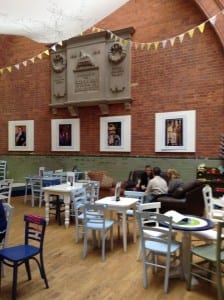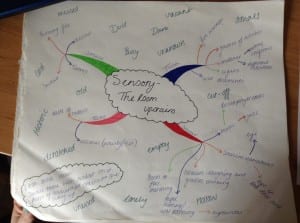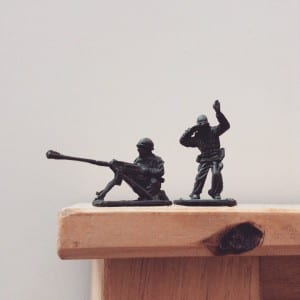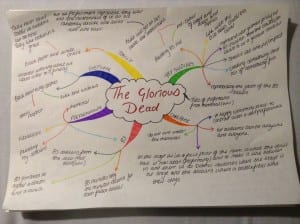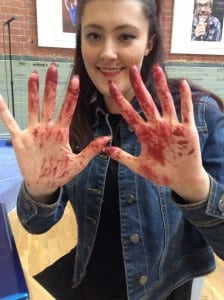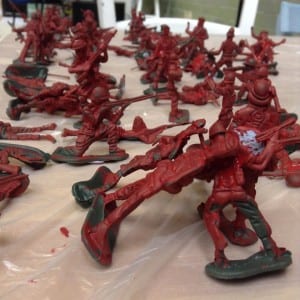Site-Specific Performance. “This term refers to a staging and performance conceived on the basis of a place in the real world” (Pavis, quoted from Pearson, 2010, 7)
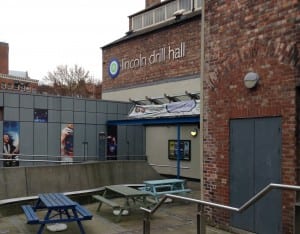
Framing Statement
Before this module I had never heard of Site-Specific performance and I must admit I was very unsure when entering it. However, after the first few visits to the site and after the first few exercises I was able to grasp a good understanding of what it was that I was going to be doing.
The Glorious Dead is a performance that memorialised soldiers from WWI who had drilled at the Lincoln Drill Hall. It was a performance full of simplicity but depth and was an emotional response to the site. We took inspiration from the Memorial that the Drill Hall has on the wall in its café and used this and the varied history of the site to fuel our research.
Throughout the process of creating our piece we were influenced by three different artworks; the work of Jake and Dinos Chapman, Field for the British Isles (1993) by Antony Gormley and A Tender Subject. We took many ideas from these works and used them to tell the story about the lives of these men. When creating our piece, each time we thought of a new idea we would sit and ask ourselves, why? Was this idea really necessary and how did it relate to the story we wanted to tell.
Research changed our idea many times until we finally came to the end performance which was an 85 minute installation performance with a pre and post-performance. The Glorious Dead was a simple repetitive piece and was a way to pay respect to 85 soldiers who had drilled at the Lincoln Drill Hall during the First World War and to whom the memorial was dedicated to. They were to be painted with red paint and set aside under the memorial to represent the death of a soldier. There was also a gunshot what went off after each minute and a soldiers name would be read out.
Last year marked the Centenary of the First World War and for the whole year people were forced to remember soldiers who had fallen. We did not want this for our piece. We did not advertise our performance like other groups, so that we would not get a controlled audience, that is to say, we would not get an audience who had come especially to see our performance. We wanted to perform our piece to whoever was in the space at the time and wanted them to choose whether to watch it or not and for how long.
Process
When creating a site-specific performance influences need to be taken from the space in relation to its relationship to the world, i.e. what its used for now, its historical dimensions and the emotions experienced with regards to the space.
First thoughts.
Prior to our meetings at the Drill Hall I had never visited the site. So before we started the module and the meetings I took a trip there myself to get a feel for the place. As I noted in my first blog post the site filled me with lots of questions; what was it originally used for? How is it used now? When was it built? to name but a few. The building itself is a warm and welcoming place. It seemed like a friendly environment but also quite dull in terms of inspiration for a piece. I was slightly disappointed by this as I was hoping to walk in and be overwhelmed with inspiration and history.
However, we later had a tour of the site where we were taken into all the rooms within the building and were told more of the history. This is when I started to understand the meaning of site-specific and was able to come up with some performance ideas that I started getting excited about.
As Pearson states the artist must be “demonstrating environmental awareness, with the environment as ecosystem and depository of socio-political realities and not as a blank canvas…” (Pearson, 33). And thanks to this tour I was able to discover hidden stories within the building from the caretaker’s courtyard to the Room upstairs and the rifle ranges under the building in the cellar which inspired me dramatically. Ideas of performing a sensory performance came into mind, exploring senses to tell a story. This was the first idea that my partner and I decided to look more into.
First Idea.
We looked into the Room Upstairs for this, hearing that it had been used during the WWI as the sergeant’s room. Interested in exploring the senses within our piece using smell, sound, taste and touch to influence what an audience member might see, we disused how this could be done to give the audience a feeling that they had been transported back through time.
This idea then progressed with more of a narrative when we found a plaque in the café with 9 sergeant’s names on and agreeing they must have been involved in this room in some way.
For this idea we created a mind map of sensory first ideas and impressions.
From this idea we gained another student to our group whose idea interested us profoundly. She wanted to use toy soldiers to replicate and miniaturise the soldiers from the Drill Hall. Inspired then by Jake and Dinos Chapman we thought of creating a miniature version of the room using the soldiers to replicate the sergeants. The rest of the actual room would be dark but still with the sensory features.
However, another group wanted to work in the same space as us with a completely different idea so we progressed down to the café to come up with another way of telling our story within the Drill Hall. We weren’t overly excited about this idea anyway and in hindsight we are glad we left and were able to come up with something we could be really proud of.
Second Idea
While we were in the café we saw the memorial on the wall and thought that instead of just focusing on the 9 sergeants, why don’t we look into all the soldiers who had died, from the hall? We came up with the idea of creating an installation similar to Antony Gormley’s Field for the British Isles, where instead of using clay figures we would use toy soldiers and fill a space with hundreds of them. However, again the room we wanted to use for this was already taken. We started to worry so we took a moment to really think, what was it that we wanted to say in our piece.
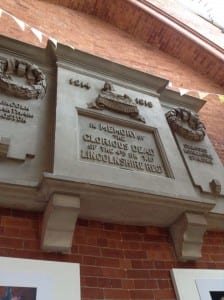
After a week or so we worked out that the café was the best place to perform our piece. It was the part of the Drill Hall with the most memorabilia about the soldiers and contained the memorial, our original piece of inspiration. But this then posed another problem. What were we going to perform?
We instantly decided that the performance was going to be simple and so to research into the soldiers more.
It took a lot of research to find a list of the soldiers who died from the 4th battalion Regiment and a couple of visits to the archives but finally we managed to find a list of 85. It was then that we knew what our story was and what we wanted our performance to show. Scraping the senses idea all together and focusing on the toy soldiers we played around with the idea of filling the café with miniature soldiers and having 85 of them painted red scattered around. This idea was inspired by an installation within the ‘A tender subject’ project. Which was a performance in London where audiences were transported around a ‘secret location’ by prison guards and were shown different performances based on stories from gay prisoners within prison. The installation that inspired us was, purple flowers planted in a room and scattered within these purple flowers were white ones representing the gay minority in male prisons. I thought this was a moving and captivating piece and I felt inspired to do something similar with toy soldiers.
We wanted to find out how many soldiers had actually been a part of the 4th Battalion however, this was an impossible task as we struggled to find out how many had died let alone all who were in it. So we bought as many soldiers as we could afford in order to create a spectacle and have a high impact on the space. We ended up getting around 700 toy soldiers.
Our group met a few times in the weeks to create the details for the piece. We knew we wanted to fill a space with the figures like Gormley and we knew we wanted it to be inspired in some way by Jake and Dinos Chapman and the installation with A Tender Subject but by this time we felt it needed a performative aspect as well, as an installation might not have the effect that we wanted. This being the case we came up with the idea that we should paint each soldier red and place them underneath the memorial.
So we started to set up our soldiers on the stage and scatter them around the café, putting them on bookcases and in plant pots and on tables. By displaying the soldiers we were able to see how they would look in the space and to actually see how we want them. For the soldiers on the stage we grouped them along the front of the space so that behind them we would have a space to paint one and still move on and off the stage. The day that we tried this was a good day to practice as the Drill hall café had many visitors and we were able to see how they reacted to the set-up, with many of them commenting that they were looking round trying to spot them all. We felt this was positive feedback and could bring the performance to the people without them feeling as though we were being forced to take part.
We all agreed that each of us needed to do something during the performance and so the three stations were created. And our performance began to have a ritual. “Rituals don’t so much express ideas as embody them.” (Schechner, 2013, 57)
The first station was at the left side of the stage, furthest away from the memorial. There would be a small minute long sand timer (a reference to the battalions time out in Egypt). The person at this station would pick a soldier and turn the timer. They would then sit and wait for the time to run out. During the performance the timer would get covered in paint creating a captivating and emotional image. This person would then move onto the second station. The paining station. This station was on the stage. The soldier that had been picked would be painted here while a numbered counter would be playing behind, counting how many soldiers had died. Originally going to be a tally we changed it to an electrical timer for the aesthetics of the piece. The other hundred or so soldiers would be in an installation in front of this station on the stage. After the minute was up and the soldier was completely painted a gunshot would go off and the person at this station would then read out a name and then move over to the final station. This was directly under the memorial. The performer would place the painted soldier down on the table under the memorial and for a minute the performer would stand there. This showed the audience the reason for doing the performance, but also this was our way of replicating the soldiers journey from starting his fight, waiting to die, dying and then being mourned and ‘remembered’.
The piece was to be done in complete silence except for the soldier’s name being read out and the gunshot. We were having a minutes silence for each soldier.
We decided that our costume would be black. Simple and characterless, but also mournful. Originally we had the idea that we would wear military uniforms so that when we got the ‘blood’ on our hands we could represent the higher ranks sending the soldiers off to die. However, with us being a group of three girls and with us wanting to pay respect to them we decided that we should dress as women of the time going to a funeral. This again was an idea that was scraped as we felt this wasn’t the image we wanted to show. In the end we went with what we would wear to a funeral. We are after all, the ones paying our respects and memorialising and ‘remembering’ these dead soldiers and so we should do this as ourselves.
I created a mind map so we could see every reason for everything we were doing. By the end we had changed some ideas that were on the plan but without having it all laid out we would not have been able to see the potential to add more or what we needed to take away.
Reasons
- The name of our performance, The Glorious Dead, came from the memorial itself. That is who it was erected in memory of.
- Performance being on the stage in the café: The stage was the perfect performance space for us as it is big and is the first thing your eyes are drawn to as you walk into the café. Using the stage also linked with us as drama students performing on a stage representing and memorialising soldiers whose own ‘stage’ would have been a battlefield.
- Out of the hundreds of toy soldiers we would pick the 85 randomly and paint them red. It would be a random selection to show the randomness of death during the war and they would be painted red as the colour represents death, blood and singles them out from the rest of the soldiers. While painting them the paint would get paint on our hands and clothes, signifying blood on our hands. We were after all the ones ‘killing’ them. The red paint was also the same colour as poppies and was actually called poppy red.
- After each minute there would be a gunshot to show a soldier had died.
- Originally putting at least one soldier on each seat with a bit of information about him, we decided that, that would be forcing our piece onto the audience. Something we had said from the beginning that we really did not want. In the end we decided that after each gunshot we would say a name. This gave the toy soldiers life.
- The use of toy soldiers was a nice link to the children’s play corner which was next our performance space but also a nod to the soldiers history. When young boys are children they play at war and now these toy soldiers are representing these boys who would have played with similar toys, representing their youth. Using these also showed a sad image. We were making something sad out of what was seen to be something fun. They are also small, which meant that we could fit more into a space and have a big impact upon an audience.
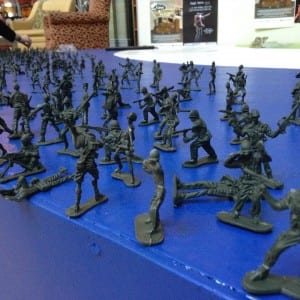
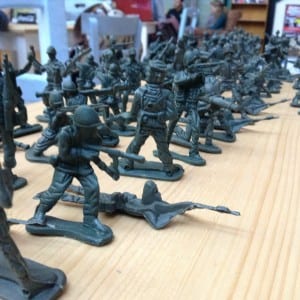
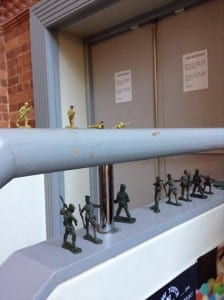
Giving the audience a choice to join in with our performance we created a little booklet and a list of all the soldiers’ names so that the audience could look during our performance and see what it was about. In the booklet there was a piece of information about four soldiers, something that we had found during our research.
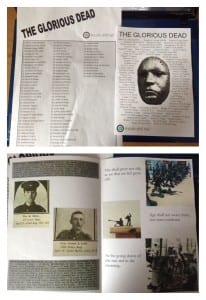
Our performance “is to be discovered in an encounter with that which lies beyond the obvious elements of the piece.” (Kaye, quoted in Pearson, 2010, 35). Although it is a relatively simple performance to understand, to really find the meaning of it you need to look deeper into the piece, really see the symbolism and the research and passion that has gone into the piece.
Evaluation
We were never just throwing ideas together in the hope of making a good performance, we were trying to tell a story and convey a piece that engages the audience with the history of the place. We are after all elements of the space.
The project was a success achieving interest from audiences, with one person taking a photo of our piece which was the way we wanted our performance to be remembered and links to a blog post I wrote on March 12th asking whether our minds are also a space and a site.
Is memory ‘space’? Although our piece is set in the Drill Hall about the Drill Halls own history can our thoughts and memories be considered ‘space’ too? The Drill Hall is, after all, our ‘site’. In our piece, the audience isn’t just watching us, they are also being forced into thinking and feeling some form of emotion towards the soldiers who spent time in this space, therefore when they leave and remember our piece and remember the soldiers and the site itself, are we still performing in their minds? Have we transferred our performance to a new space whilst keeping the same site?
We achieved the image we wanted with our hands being covered in red paint.
When we were painting the soldiers we noticed how we did actually start to feel bad about doing so and when painting their faces we felt as though we were dehumanising them, which is what was happening. At the end of our performance we left them under the memorial as the final image, it was a very moving image with 85 soldiers all lined up like they would be in a cemetery.
The feedback we got from the piece from our audience was very good, with people saying they clearly understood it and felt moved and compelled to think of the soldiers.
There is a “role of language” (Pearson, 2010, 101) in Site even in our performance where there is very little talking at all. The language of the piece is shown through our actions and ritual routine of what we were doing. The painting of the soldiers and the silence is the key voice in our performance. We want the audience to relate and feel something for the piece as much as we, the performers do.
Our pre and post-performance was the set up and take down of our piece. Both of these were meant to last about an hour each and had done so in a rehearsal we had done the previous day, however, on the day of the performance they did not last so long so our piece finished earlier than expected. It was good for us as we were then able to ask people how they felt about our piece, see other performances and reflect upon the performance we had just done however, it was a shame it didn’t last as long as we had planned for. However, the 85 minutes was the important time in our project and that went to plan.
Our piece was a circuit, a production line. The feedback we received was that the image was quite striking with us being three women. If it had have been three men doing the performance that we had done the image and attitude towards the piece would have been very different.
I feel immensely proud of the piece and I know it captured the passion that we felt about it.
3269 Words
Bibliography
Pearson, M. (2010) Site-specific Performance. London: Palgrave Macmillan
Jones, A. (2009) Performance: Time, Space and Cultural ‘Value’. In: David Cross and Claire Doherty (eds.) One Day Sculpture. Germany: Kerber Verlag. 31-42
Schechner, R. (2013) Performance Studies: An Introduction. 3rd edition. Oxon: Routledge
Kaye, N. (1996) Site/Intermedia, Performance Reasearch. 63-69
A Tender Subject – http://www.artangel.org.uk//projects/2012/a_tender_subject/video/video_a_tender_subject
Jake and Dinos Chapman – http://jakeanddinoschapman.com/

